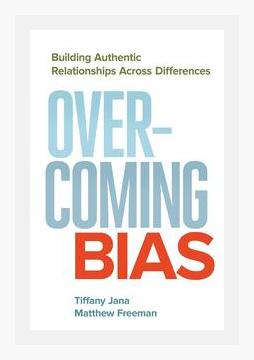Human Resources and Talent ManagementDiversity and Inclusion
Introduction:
“Overcoming Bias: Building Authentic Relationships Across Differences” by Tiffany Jana and Matthew Freeman explores the pervasive issue of unconscious bias, offering strategies for recognizing and overcoming these biases. This summary distills the authors’ key points and actionable steps into a clear, structured format.
1. Understanding Bias
Major Point: Bias is an inherent aspect of being human, as our brains are wired to categorize information quickly to make sense of the world.
- Example: The authors discuss the concept of “in-group” and “out-group” biases, where individuals show preference for those who are similar to them.
- Action: Take an Implicit Association Test (IAT) to become aware of your unconscious biases. Harvard University’s Project Implicit offers several tests that can help you discover your implicit biases related to race, gender, and other categories.
2. Personal Reflection and Self-Awareness
Major Point: Personal reflection is critical to uncover your own biases and understand their impact on your behavior and decisions.
- Example: Matthew Freeman shares his experience of realizing his own biases after minority colleagues pointed out his preferential treatment toward individuals from similar backgrounds.
- Action: Keep a bias journal. Write down your interactions and reflect on whether any of your decisions or feelings were influenced by unconscious biases. Over time, patterns may emerge that highlight areas needing improvement.
3. The Value of Vulnerability
Major Point: Vulnerability is necessary for growth and fostering authentic relationships. Sharing personal experiences and admitting biases can build trust.
- Example: Tiffany Jana recounts a workshop where she shared her own biases with the group, which encouraged others to open up and have honest conversations.
- Action: Practice vulnerability by sharing stories about your own biases with colleagues or friends. This could be in the form of a discussion group or part of a diversity and inclusion workshop.
4. Mindfulness and Active Listening
Major Point: Mindfulness and active listening are crucial in becoming aware of and addressing biases.
- Example: The authors describe a scenario where a leader practiced active listening by repeating back what was heard to confirm understanding, which helped in acknowledging the employee’s concerns.
- Action: During conversations, focus intently on the speaker without interrupting. After they finish, summarize what you heard and ask if you understood correctly. This shows respect and helps to mitigate biases that might distort communication.
5. Building Empathy and Connection
Major Point: Empathy is fundamental to overcoming biases and building authentic relationships across differences.
- Example: The book explains how engaging in community service projects can bridge gaps and build empathy between diverse groups.
- Action: Volunteer for organizations or projects that serve different communities. Engaging in community service can expose you to different perspectives and help build empathy for others’ experiences.
6. Challenging Stereotypes
Major Point: Stereotypes reinforce biases and must be actively challenged to create an inclusive environment.
- Example: The authors explored the impact of media portrayal of different races and genders, which reinforces stereotypes and biases.
- Action: Consistently challenge stereotypes when you encounter them. For instance, if someone makes a stereotypical comment, calmly question it and provide alternative perspectives or examples.
7. Education and Continuous Learning
Major Point: Education about different cultures, backgrounds, and experiences is ongoing and essential for overcoming bias.
- Example: The book highlights various D&I workshops that provide educational content and activities designed to increase awareness and understanding.
- Action: Commit to lifelong learning by reading books, attending workshops, and participating in training sessions focused on diversity and inclusion.
8. Creating Inclusive Environments
Major Point: It’s important to create environments where everyone feels valued and included.
- Example: The authors discuss inclusive practices such as equitable hiring practices, creating safe spaces for dialogue, and celebrating diverse cultural holidays.
- Action: Advocate for or initiate policies in your workplace that focus on diversity and inclusion. This could involve forming a D&I committee, conducting bias training, or celebrating inclusivity through events and discussions.
9. Measuring Progress
Major Point: Set measurable goals to track progress in overcoming biases and fostering inclusion.
- Example: An organization utilized employee surveys to measure the climate of inclusion and identify areas needing improvement.
- Action: Develop metrics to measure diversity and inclusion within your organization. Use surveys, feedback mechanisms, and diversity audits to evaluate and improve your efforts continuously.
10. Accountability and Allyship
Major Point: Holding oneself and others accountable is critical in the journey of overcoming bias.
- Example: The authors illustrate the importance of allyship through stories where allies stood up against biased behaviors and supported marginalized individuals.
- Action: Act as an ally by standing up against biased remarks or actions you witness. Support marginalized colleagues by advocating for their ideas and contributions in meetings.
Conclusion:
In “Overcoming Bias: Building Authentic Relationships Across Differences,” Jana and Freeman provide a comprehensive guide on recognizing and mitigating unconscious biases. The key to fostering authentic relationships across differences lies in continuous education, active reflection, vulnerability, and accountability. By taking specific, actionable steps such as those provided in the book, individuals and organizations can move towards a more inclusive and equitable environment.
Action Plan:
- Self-awareness and Reflection:
- Take the IAT.
-
Keep a bias journal.
-
Vulnerability and Trust Building:
-
Share personal experiences with biases in group settings.
-
Mindfulness and Active Listening:
-
Practice repeating back what you heard to confirm understanding.
-
Empathy and Connection:
-
Volunteer in diverse community service projects.
-
Challenging Stereotypes:
-
Actively question and provide alternate perspectives to stereotypes.
-
Education and Continuous Learning:
-
Regularly attend D&I workshops and training sessions.
-
Creating Inclusive Environments:
-
Advocate for inclusive policies and practices at work.
-
Measuring Progress:
-
Develop and use metrics to evaluate diversity initiatives.
-
Accountability and Allyship:
- Act as an ally by standing against biased behaviors and supporting marginalized colleagues.
Human Resources and Talent ManagementDiversity and Inclusion
